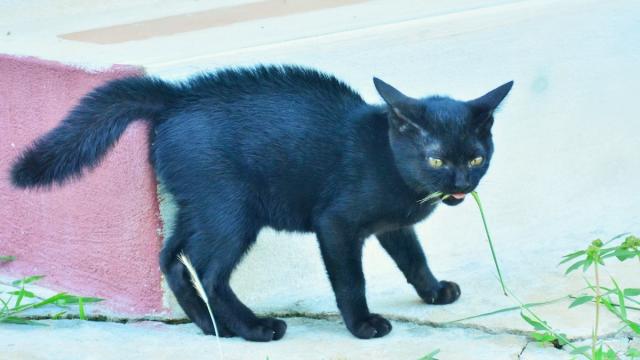
Why Does My Cat Make Weird Noises When Playing?
Have you ever wondered why your cat makes strange noises while playing? From chirping and chattering to howling and growling, these vocalizations can be both amusing and puzzling. In this article, we will delve into the fascinating world of cat play noises, exploring their meanings and providing insights into your feline friend’s playful behavior.
While cats communicate primarily through body language and scent, vocalizations play a crucial role in kitten development and adult cat interactions. Playtime is one such context where cats use a variety of sounds to express themselves, from excitement and joy to frustration or aggression.
Chattering and Chirping
One of the most common noises cats make during play is chattering. This sound is characterized by a rapid succession of short, high-pitched clicks or chirps. While the exact reason for chattering is still unknown, it is believed to be a form of excitement or anticipation. Kittens often chatter when they are about to pounce on a toy or when they are being petted.
Chirping is another high-pitched sound that cats make. It is similar to chattering but is typically longer and more sustained. Chirping is often seen in cats that are stalking prey or playing with a toy. It is thought to be a way for cats to communicate with each other or to attract their attention.
Howling and Growling
While chattering and chirping are typically associated with playful behavior, howling and growling can indicate more aggressive intentions. Howling is a long, drawn-out vocalization that cats use to express pain, fear, or anger. Growling is a low, guttural sound that cats use to warn off potential threats.
If your cat is making howling or growling noises during play, it is important to pay attention to their body language and the context of the situation. If your cat is also flattened to the ground, has dilated pupils, or is hissing, they may be feeling threatened or aggressive. In this case, it is best to end the play session and give your cat some space.
Other Noises
In addition to the vocalizations mentioned above, cats can also make a variety of other noises during play. These noises can include meowing, purring, and hissing. Meowing is typically used to communicate with humans, but cats may also meow during play to get the attention of their playmate.
Purring is a low, rumbling sound that cats make when they are content or relaxed. However, cats may also purr during play when they are feeling particularly excited or playful. Hissing is a harsh, high-pitched sound that cats use to express fear or aggression. If your cat is hissing during play, it is important to end the session and give them some space.
Tips and Expert Advice
Here are some tips and expert advice for understanding and responding to your cat’s play noises.
**Pay attention to your cat’s body language.** Your cat’s body language will give you clues about their mood and intentions. If your cat is flattened to the ground, has dilated pupils, or is hissing, they may be feeling threatened or aggressive. In this case, it is best to end the play session and give your cat some space.
**Use interactive toys.** Interactive toys can help to keep your cat entertained and engaged during playtime. Cats enjoy toys that they can chase, pounce on, and bat around. Avoid using toys that are too small or that could be easily swallowed.
**Make sure your cat has plenty of space to play.** Cats need space to run, jump, and pounce. If your cat is confined to a small space, they may become bored or frustrated, which can lead to excessive vocalizations.
FAQs on Cats and Play Noises
Q: Why do cats make weird noises when they play?
A: Cats make various noises during play to communicate with each other, express excitement, and signal their intentions.
Q: What does it mean when my cat chatters?
A: Chattering is a high-pitched clicking sound that cats make when they are excited or anticipating something.
Q: Why does my cat howl during play?
A: Howling is a long, drawn-out vocalization that cats use to express pain, fear, or anger. If your cat is howling during play, it is important to pay attention to their body language and the context of the situation.
Q: What should I do if my cat is making aggressive noises during play?
A: If your cat is making aggressive noises during play, such as howling or growling, it is important to end the play session and give them some space.
Q: How can I tell if my cat is enjoying playtime?
A: Signs that your cat is enjoying playtime include purring, dilated pupils, and playful body language, such as pouncing and chasing.
Conclusion
Understanding the different noises cats make during play can help you to better bond with your furry friend and provide them with the best possible environment for play and socialization. Whether your cat is chattering, chirping, howling, or growling, their vocalizations are a window into their inner world of thoughts and emotions.
Are you interested in learning more about cat play noises? If so, I encourage you to do some additional research online or consult with a certified animal behaviorist. By deepening your understanding of your cat’s vocalizations, you can enhance your bond with them and create a more fulfilling and enjoyable relationship.

Image: www.yahoo.com

Image: www.reddit.com
Biting, Scratching and Spraying – Correcting Your Cat’s Bad Behavior | Hartz Mar 1, 20244. Growling. Growling is a warning to other cats (and people!) to keep their distance. A growling cat may also flatten their ears, puff up their fur, hiss, and swish their tails from side to side